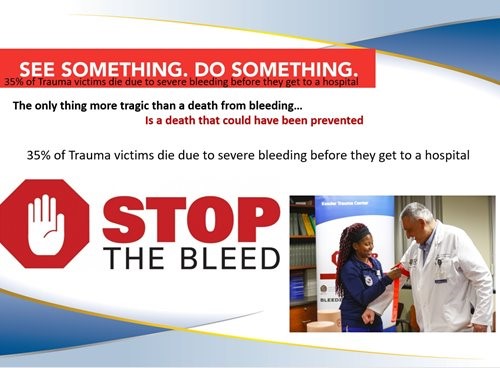Outreach & Injury Prevention
 2022 Video Review of
2022 Video Review of
Trauma Outreach
Stop the Bleed
Massive bleeding from any cause, but particularly from an active shooter or explosive event where a response is delayed can result in death. Similar to how the general public learns and performs CPR, the public must learn proper bleeding control techniques, including how to use their hands, dressings, and tourniquets. Victims can quickly die from uncontrolled bleeding, within five to 10 minutes.
For more information about Stop the Bleed, visit StopTheBleed.org
You can also search for local classes or contact the Trauma Program or your local Fire Department/EMS Organization to arrange a class for a private group training.
To request Stop the Bleed training, fill out the Stop the Bleed Training form by clicking the link or scanning the QR code to the right
Distracted Driving
This teen driving program is held at regional high schools and youth groups and aimed at teenage drivers and passengers. The goal of this program is to present teenagers with the dangers of reckless and distracted driving to reduce the number of motor vehicles crashes. During this course, teenagers learn the different types of distractions that threaten their safety on the roadway. Teens also learn how the graduated driver’s license program minimizes their threat of motor vehicle crash if restrictions are followed correctly. The presentation is engaging to optimize participation and create a long lasting impression.
Rochester Youth Violence Partnership
We believe youth violence is a community health problem that requires a community solution. The Rochester Youth Violence Partnership (RYVP) is a hospital-based violence intervention program that targets trauma victims under the age of 18 when they present for medical care following a knife or gun injury. Established in 2006, the RYVP is a partnership headed by the Medical Center’s regional trauma center and supported by 28 local nonprofit, government, and service-based organizations. The hospital serves as the “first responder” by recognizing the problem, identifying at-risk patients, and treating injuries. Once the patient is stabilized and the psycho-social issues identified, a coordinated series of law-enforcement and community partner-led interventions occur to help reduce violence in this vulnerable population.
The RYVP was Honored Nationally.
Project T.I.P.S.
T.I.P.S. stands for Trust, Information, Programs, and Services. Our goal is to encourage the exchange of information through community outreach and neighborhood events.
Community Outreach: Members from the Rochester Police Department, Rochester Fire Department, Project Exile, PAVE, Pathways to Peace, Rise Up Rochester, local law enforcement, community organizations and Kessler Trauma Center will be visiting door-to-door in neighborhoods to build relationships between citizens and services.
For more information, please contact the Trauma Program.
Smartphone Emergency Medical ID
The Smartphone Emergency Medical ID (SEMID) program is based on research done by our Trauma Medical Director, Dr. Michael Vella, and his colleagues that identified a need to educate the public and medical providers on this feature of a device that nearly every individual now carries with them all the time. We partner with local first response agencies to increase awareness of this component, and provide them with educational materials that they can use when interacting with members of the public to help increase awareness and use of this potentially life-saving tool of their smartphone.
The Trauma Program produced several videos on how to set up this feature on different types of smart phones and can be viewed through the Kessler Trauma Center YouTube channel.
Firearm Injury Prevention Program
The mission of the Firearm Injury Prevention Program (FIPP) is to collaborate with health care providers, community agencies, and community members in Rochester and the Finger Lakes region to find effective ways to prevent firearm-related suicide, unintentional injury and death, assaults, and homicides through education, resource-sharing, research, and open dialogue. We hope to capitalize on common ground that recognizes the urgency regarding this public health concern and the importance of addressing a modifiable risk factor: firearm safety for both firearm owners and non-owners.
Learn more about the Firearm Injury Prevention Program.